HEALTH SERVICES
What influences frequent attenders in primary care?
Older age and GMS eligibility were found to be associated with significantly higher attendance rates to primary care
January 14, 2014
-
Frequent attendance by patients to primary care accounts for a relatively large proportion of contacts with GPs and a high number of referrals and prescriptions. Frequent attenders have high levels of physical, psychological and social morbidity and much of GPs’ work therefore relates to these patients.1,2 Frequent attenders have also been found to be less likely to try self-care3 and more likely to use other health services.3,4
There is no generally accepted definition of frequent attendance and many cut-off figures have been used.3,4 It has been argued that the use of percentiles rather than an absolute figure to determine the cut-off figure allows for more meaningful comparison between practices as it accounts for the possibility of variation in consultation rates between practices.1
Although multimorbidity and chronic disease are associated with frequent attendance in primary care,3,5 it has also been found that frequent attenders in primary care are not restricted to particular groups of morbidity and that there is an aspect of frequent attendance that is characteristic of individuals regardless of the symptoms with which they consult.6 However, some morbidities are more prominent than others in this group of consulters, and this may help guide practice policies and future research into frequent consulters.
The study of frequent attendance also has particular relevance in light of the current economic climate and future budgetary concerns of the health system. Frequent attenders consist of a relatively small group of patients but consume a large amount of healthcare resources.7 Analysis of frequent attendance would enable the identification of particular patient groups that require and consume a lot of resources. These groups could then be targeted to receive specific interventions in an effort to improve quality and reduce cost.
Aims of the study
- To obtain a statistical description of patient attendance in two primary healthcare practices in north Clare over a 12 month period
- To determine how the patient factors of age, gender and GMS status are distributed among the primary care population and if they are associated with a high level of healthcare use
- To determine if the pattern of healthcare use follows the 80:20 rule, which states that 80% of the effects result from 20% of the causes; in this case, to see if 80% of primary healthcare use is accounted for by 20% of the population.
Methods
Healthcare use for the purposes of this study is defined as primary care consultations recorded in the patient record.
Study population
The sample data was extracted from the databases of two GP practices with four GPs in north Clare over the defined study period of a year, arbitrarily selected as December 8, 2009 to December 9, 2010. The study population (n=3,883) consisted of individuals who made at least one visit to either of the two study practices during the study period.
Study variables
Healthcare use was measured in terms of primary care consultations (GP or practice nurse). The data collected included:
- The total number of visits made by each individual to the practices within the study period
- Age
- Gender
- Patient type, ie. whether GMS or private.
For the purpose of analysis and the study, subjects were divided by age into the following groups: <5 years, 5-17 years, 18-44 years, 45-64 years and >65 years.
Analysis
Comparison of mean total visits was carried out for both gender and patient type groups, using an independent samples t-test. Comparison of mean total visits for the different age groups was carried out using one-way analysis of variance (ANOVA). Statistical analysis was carried out using PASW Statistics 18 statistical analysis software.
Results
There were 23,403 unique attendances to the two primary care centres during the one-year period of the study, an average of 105 per working day or 35 per whole time equivalent GP. A total of 3,883 individuals accounted for these attendances, giving an average of six visits per patient per year. The breakdown of this population by gender was 1,831 (47.72%) female and 2,052 (52.28%) male.
The breakdown by patient type was 1,840 (47.39%) GMS and 2,043 (52.61%) private. The proportion of GMS patients as a percentage of the total number of patients registered with both practices was 32.44% (2,615). The total number of patients registered was 8,173.
Frequent attenders were defined by analysis of the total visits data as the set of individuals with greater than or equal to the 75th centile of visits. Table 1 shows a breakdown of visit totals for individual patients into various centiles.
Table 2 shows the attendance statistics for the various age bands. These show that attendance was higher in the <5 age group than in the 5-17 and 18-44 age groups. Attendance then rises for the 45-64 age group, with the most significant rise being in the >65 age group. This was found to be statistically significant (F=212.476, p<0.001). These results are displayed graphically in Figure 1.
Table 3 displays the attendance statistics for patient type and gender. GMS patients had an increased mean attendance over private patients. This was found to be statistically significant (t = 24.254, p<0.001). Females were also found to have an increased mean attendance over males. This was also found to be statistically significant (t = 4.697, p<0.001).
Figure 2 shows attendance breakdown by gender for each of the visit bands. Figure 3 shows the attendance breakdown by patient type for each of the visit bands.
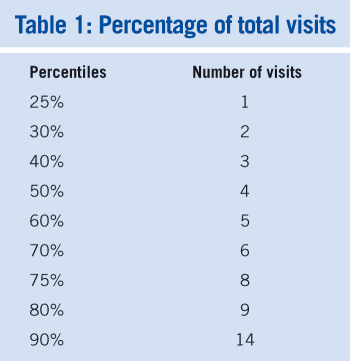 (click to enlarge)
(click to enlarge)

 (click to enlarge)
(click to enlarge)
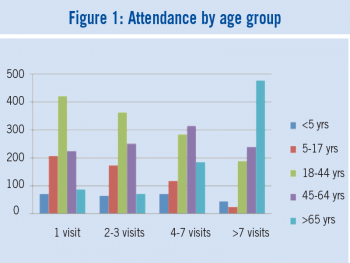 (click to enlarge)
(click to enlarge)
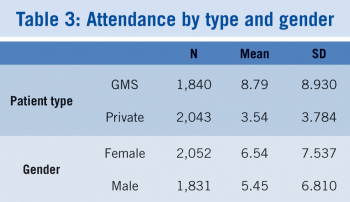 (click to enlarge)
(click to enlarge)
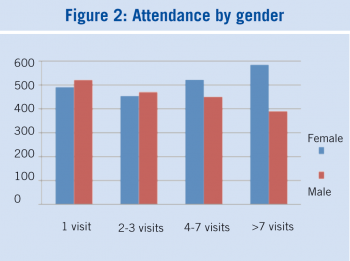 (click to enlarge)
(click to enlarge)
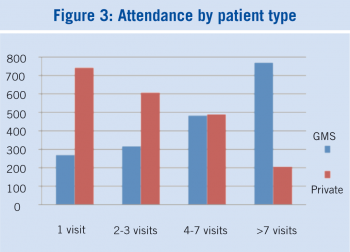 (click to enlarge)
(click to enlarge)